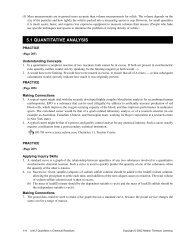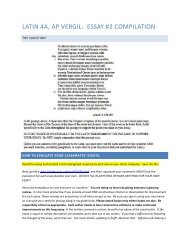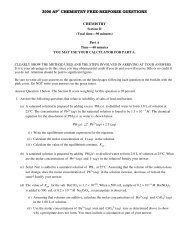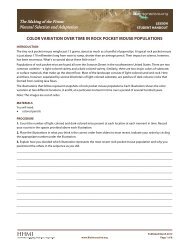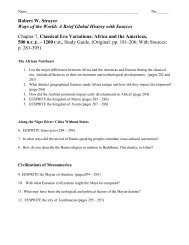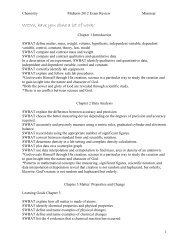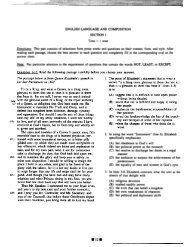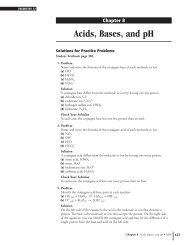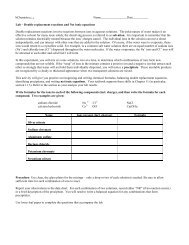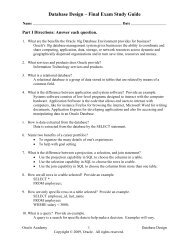Navy Funerals at Arlington - Quia
Navy Funerals at Arlington - Quia
Navy Funerals at Arlington - Quia
Create successful ePaper yourself
Turn your PDF publications into a flip-book with our unique Google optimized e-Paper software.
NAVAL<br />
FUNERALS<br />
AT ARLINGTON NATIONAL CEMETERY<br />
BUREAU OF NAVAL PERSONNEL<br />
NAVPERS 15956D
INTRODUCTION<br />
This manual serves as a guide for personnel design<strong>at</strong>ed as Escort Commanders or other<br />
participants in <strong>Navy</strong> funerals <strong>at</strong> <strong>Arlington</strong> N<strong>at</strong>ional Cemetery. It may also be used as a<br />
general guide for all <strong>Navy</strong> funerals since most of these procedures are standard.<br />
<strong>Navy</strong> military funerals are based on simple customs and traditions. Such funerals are open<br />
recognition of the N<strong>at</strong>ion’s debt for the services and sacrifices of its <strong>Navy</strong> men and<br />
women. The ceremonial customs comprising the elements of a naval funeral are rooted in<br />
ancient naval and military tradition. These customs have come to assume a deeper<br />
significance than th<strong>at</strong> of mere b<strong>at</strong>tlefield expediency.<br />
The flag th<strong>at</strong> covers the casket today symbolizes the services of the deceased in the Armed<br />
Forces of the United St<strong>at</strong>es; the N<strong>at</strong>ion regards the burying of its military dead as a solemn<br />
and sacred oblig<strong>at</strong>ion. The three volleys th<strong>at</strong> are fired, according to ancient belief, were to<br />
scare away evil spirits. It is appropri<strong>at</strong>e th<strong>at</strong> Taps be played over the grave to mark the<br />
beginning of the last, long sleep, and to express hope and confidence in an ultim<strong>at</strong>e reveille<br />
to come. The reversal of rank <strong>at</strong> funerals is an acknowledgment th<strong>at</strong> in de<strong>at</strong>h, all persons<br />
are equal. This is signified by positioning the honorary pallbearers and all other mourners,<br />
if practicable, in reverse order of rank.<br />
In the Washington, D.C. area, funeral ceremonies for the <strong>Navy</strong> and Coast Guard are under<br />
the supervision of the Commandant, Naval District Washington. They follow a p<strong>at</strong>tern<br />
based on United St<strong>at</strong>es <strong>Navy</strong> Regul<strong>at</strong>ions, with modific<strong>at</strong>ions resulting from local<br />
conditions, customs and traditions.<br />
M.S. DEBIEN<br />
Captain, U.S. <strong>Navy</strong><br />
Director, Personal, Family<br />
and Community Support Division<br />
17 September 1993<br />
(D<strong>at</strong>e)<br />
Original printing 1951<br />
Revised 1954<br />
Revised 1956<br />
Revised 1960<br />
Revised 1962<br />
Revised 1966<br />
Revised 1972<br />
Revised 1980<br />
Revised 1983<br />
Revised 1993
SECTION<br />
1. General Inform<strong>at</strong>ion<br />
2. Composition of a Naval Funeral Escort<br />
3. The Escort Commander<br />
4. Chapel Service<br />
5. Transfer<br />
6. Grave Service<br />
7. The Procession to the Grave<br />
8. Committal Service <strong>at</strong> the Grave<br />
9. Personal Flag Bearer<br />
10. Casket Bearers<br />
11. Honorary Pallbearers<br />
12. Folding the Flag<br />
13. Miscellaneous<br />
14. Mass Burials<br />
TABLE OF CONTENTS<br />
Appendix A: Table of Entitlements for Military <strong>Funerals</strong>
SECTION 1<br />
GENERAL INFORMATION<br />
ART. 1-1. Three types of naval funerals are conducted <strong>at</strong> <strong>Arlington</strong> N<strong>at</strong>ional Cemetery:<br />
1. Full Honor<br />
2. Simple Honor<br />
3. Dependent<br />
ART. 1-2. The following persons are eligible for burial in <strong>Arlington</strong> N<strong>at</strong>ional Cemetery:<br />
1. Persons on active duty in the Armed Forces.<br />
2. Retired members of the Uniformed Services who have performed active Federal<br />
Services, are carried on official service retired lists and who are eligible to receive<br />
compens<strong>at</strong>ion stemming from service in the Armed Forces. Retired members include<br />
members of the Naval Fleet Reserve, Retired Reservists, age 60, who are receiving retired<br />
pay and Retired Reservists who would have been eligible for retired pay, but die before<br />
reaching age 60.<br />
3. Recipients of the Medal of Honor and any former member of the Armed Forces whose<br />
last active duty military service (other than for training) termin<strong>at</strong>ed honorably and who has<br />
been awarded the Distinguished Service Cross (Air Force Cross or <strong>Navy</strong> Cross), the<br />
Distinguished Service Medal, the Silver Star or the Purple Heart.<br />
4. Former members of the Armed Forces, separ<strong>at</strong>ed for a medical service-connected<br />
disability of 30% or gre<strong>at</strong>er prior to 1 October 1949, who had served on active duty (other<br />
than for training) and who would have been eligible for retirement under the provisions of<br />
10 U.S.C. 1201 had th<strong>at</strong> st<strong>at</strong>ute been in effect on the d<strong>at</strong>e of separ<strong>at</strong>ion.<br />
5. Persons otherwise eligible by reason of honorable military service who had also held<br />
elective office in the U.S. Government or served on the Supreme Court or the Cabinet or<br />
in an office compens<strong>at</strong>ed <strong>at</strong> Level II under the Executive Salary Act.<br />
6. The spouses, minor children and dependent adult children of the persons listed in (1)<br />
through (5) above and of persons already buried in <strong>Arlington</strong> N<strong>at</strong>ional Cemetery.<br />
ART. 1-3. The crem<strong>at</strong>ed remains of the following persons are eligible for burial in the<br />
Columbarium in <strong>Arlington</strong> N<strong>at</strong>ional Cemetery:<br />
1. Any honorably discharged veteran and/or,<br />
2. His/her dependents (Those persons who are eligible for interment in <strong>Arlington</strong> N<strong>at</strong>ional<br />
Cemetery who meet the criteria in ART. 1-2 shall have the option of burial in either a plot<br />
or the Columbarium). The ceremonies and honors described in this manual for interments<br />
are conducted in the same manner on the pl<strong>at</strong>form site outside the Columbarium.
ART. 1-4. Full Honor and Simple Honor funerals differ primarily in the size of the<br />
funeral escort and in the other elements particip<strong>at</strong>ing in the funeral. The Table of<br />
Entitlements, Appendix A to this manual, indic<strong>at</strong>es the types of funerals to which naval<br />
personnel are entitled.<br />
ART. 1-5. Dependent funerals are conducted for the spouse or dependent children of<br />
naval personnel who are entitled to burial <strong>at</strong> <strong>Arlington</strong> N<strong>at</strong>ional Cemetery.<br />
ART. 1-6. The basic elements of Full Honor and Simple Honor funerals are:<br />
1. American flag draped over the casket.<br />
2. Honors rendered during each movement of the casket.<br />
3. The appropri<strong>at</strong>e religious service.<br />
4. The procession to the grave.<br />
5. The appropri<strong>at</strong>e graveside committal service.<br />
6. Honors rendered <strong>at</strong> the grave while three rifle volleys are fired and a bugler sounds<br />
Taps.<br />
7. Present<strong>at</strong>ion of the flag to the next of kin by an appropri<strong>at</strong>e <strong>Navy</strong> represent<strong>at</strong>ive.<br />
ART. 1-7. FULL HONOR FUNERAL. A color detail and a ceremonial band are<br />
provided in addition to the escort specified in Appendix A. The band plays prescribed<br />
musical honors and/or a hymn during each movement of the casket. The color detail, band<br />
and escort march in the procession and the casket is borne to the grave on a horse drawn<br />
caisson.<br />
ART. 1-8. SIMPLE HONOR FUNERAL. No color detail or band are provided, and<br />
the escort does not march in the procession. The casket is borne to the grave in a coach.<br />
ART. 1-9. DEPENDENT FUNERAL. There are no military honors in connection with<br />
this funeral, and no flag is provided. The military casket bearer detail departs after placing<br />
the casket <strong>at</strong> the grave.<br />
ART. 1-10. Each of the <strong>Navy</strong> funerals conducted <strong>at</strong> <strong>Arlington</strong> N<strong>at</strong>ional Cemetery is<br />
c<strong>at</strong>egorized according to the loc<strong>at</strong>ion of the religious service. When the service is held <strong>at</strong><br />
the Ft. Myer Chapel, the funeral is identified as a Chapel Service. When the religious<br />
service is held <strong>at</strong> any other church or in a funeral home, or when there is only a graveside<br />
religious service, the funeral is identified as a Ft. Myer G<strong>at</strong>e, Memorial G<strong>at</strong>e, P<strong>at</strong>ton<br />
Circle, Coast Guard Monument, Old Administr<strong>at</strong>ion Office Transfer or Grave Service.<br />
ART. 1-11. MILITARY HONORS<br />
1. Military honors <strong>at</strong> naval funerals consist of the escort and firing party <strong>at</strong> the position of<br />
PRESENT ARMS and all other military personnel in uniform, and not in ranks, <strong>at</strong> the<br />
position of HAND SALUTE.
2. Military honors are rendered during each movement of the casket, during each<br />
movement of the casket, during the firing of volleys, and during the sounding of Taps.<br />
3. For Full Honor funerals of officials and officials entitled to a gun salute, the following<br />
military honors are rendered.:<br />
a. Prescribed musical honors consisting of ruffles and flourishes.<br />
b. Minute guns, fired during the procession to the grave in the cemetery.<br />
c. A gun salute fired during the graveside committal service.<br />
4. No additional honors are rendered during Simple Honor funerals.<br />
ART. 1-12. St<strong>at</strong>e, Official and Special Military funerals are conducted in accordance<br />
with OPNAVINST 5360.1 series when directed by the Department of Defense. Armed<br />
Forces Full Honor funerals are conducted in accordance with Military District of<br />
Washington Standard Oper<strong>at</strong>ing Procedures when directed by the Department of Defense.<br />
All other funerals for personnel of the naval service are conducted in accordance with this<br />
manual.<br />
ART. 1-13. All military personnel in uniform, whether particip<strong>at</strong>ing in or <strong>at</strong>tending the<br />
graveside committal service, remain covered during the committal service unless their<br />
religious tradition dict<strong>at</strong>es otherwise. During military honors, personnel in uniform render<br />
the HAND SALUTE.<br />
ART. 1-14. The Chief of Naval Personnel (CNP) is represented <strong>at</strong> <strong>Arlington</strong> N<strong>at</strong>ional<br />
Cemetery funerals. The represent<strong>at</strong>ive <strong>at</strong>tends the funeral, and <strong>at</strong> the close of the<br />
graveside committal service extends the condolences of the CNP to the next of kin.<br />
Appropri<strong>at</strong>e seasonal full dress uniform is worn when particip<strong>at</strong>ing in both full honors and<br />
simple honors funerals.<br />
1. A Commander selected from the BUPERS w<strong>at</strong>chbill represents the CNP <strong>at</strong> the funeral<br />
of an active duty officer (through rank of Commander), an active duty enlisted member or<br />
a holder of the Congressional Medal of Honor.<br />
2. A Captain selected from the BUPERS w<strong>at</strong>chbill represents the CNP <strong>at</strong> a funeral of an<br />
active duty Captain or retired Rear Admiral.<br />
3. A Rear Admiral is design<strong>at</strong>ed by ADC’s (N1B) office as CNP represent<strong>at</strong>ive <strong>at</strong> a<br />
funeral of a retired Vice Admiral or full Admiral. The CNP represent<strong>at</strong>ive for an active<br />
duty Rear Admiral, Vice Admiral or full Admiral will be determined <strong>at</strong> the time of demise.<br />
ART. 1-15. The flag is presented to the next of kin by a U.S. Government official. It is<br />
the responsibility of the cemetery represent<strong>at</strong>ive to ensure present<strong>at</strong>ion to the proper<br />
person. In Full Honor funerals of officers or officials entitled to a gun salute, the Escort<br />
Commander will make the actual present<strong>at</strong>ion of the flag to the next of kin. This will be<br />
done in all cases, whether or not a chaplain is present. In all other naval funerals, the
chaplain will present the flag to the next of kin. If no chaplain is present, the CNP<br />
represent<strong>at</strong>ive or the officer in charge of the ceremonial guard will make the present<strong>at</strong>ion.<br />
ART. 1-16. An additional U.S. Flag (identical to the one presented to the<br />
widow/widower or child) will be presented to the parents (2 flags if parents are separ<strong>at</strong>ed)<br />
of the deceased in <strong>at</strong>tendance <strong>at</strong> the graveside committal service. The chaplain and the<br />
Escort Commander will present the flags. If no chaplain is present, the CNP<br />
represent<strong>at</strong>ive, petty officer in charge, escort for the remains or cemetery represent<strong>at</strong>ive, in<br />
th<strong>at</strong> order, will present the second flag.<br />
ART. 1-17. Naval personnel particip<strong>at</strong>ing in the escort and other units in funerals <strong>at</strong><br />
<strong>Arlington</strong> N<strong>at</strong>ional Cemetery are considered members of the U.S. <strong>Navy</strong> Ceremonial<br />
Guard. The U.S. <strong>Navy</strong> Band provides all ceremonial bands and buglers for such funerals.
ART. 2-1. FULL HONOR FUNERAL<br />
SECTION 2<br />
COMPOSITION OF A NAVAL<br />
FUNERAL ESCORT<br />
1. SPECIAL FULL HONOR (COMBINED). This ceremony will be conducted when<br />
directed by the Department of the <strong>Navy</strong> for officials (less 4 star admiral) listed in the Table<br />
of Entitlements. The escort and other particip<strong>at</strong>ing elements consist of the following:<br />
a. The escort commander.<br />
b. The OIC of the funeral.<br />
c. The commander of troops: A Ceremonial Guard Officer with a staff of two<br />
officers, one <strong>Navy</strong> officer and one Marine Corps Officer as adjutant.<br />
d. The <strong>Navy</strong> ceremonial band.<br />
e. The escort: A combined b<strong>at</strong>talion consisting of one Marine Corps company and<br />
one <strong>Navy</strong> company. Each company is comprised of a company commander with guidon<br />
bearer and two pl<strong>at</strong>oons, each pl<strong>at</strong>oon with a pl<strong>at</strong>oon petty officer, right guide and three<br />
squads of six persons.<br />
f. A combined color detail.<br />
g. A <strong>Navy</strong> personal flag bearer.<br />
h. A six person <strong>Navy</strong> casket bearer detail.<br />
i. A seven person Marine Corps firing party with NCOIC.<br />
2. SPECIAL FULL HONOR. Conducted for a 4 star admiral . The escort and other<br />
particip<strong>at</strong>ing elements consist of the following:<br />
a. The escort commander.<br />
b. The OIC of the funeral.<br />
c. The commander of troops: A Ceremonial Guard officer with guidon bearer.<br />
d. The <strong>Navy</strong> ceremonial band.<br />
e. The escort: A single b<strong>at</strong>talion consisting of two companies. Each company<br />
comprised of two pl<strong>at</strong>oons with company officer, each pl<strong>at</strong>oon with a pl<strong>at</strong>oon officer,<br />
right guide and three squads of five persons (no right guide for 1st and 3rd pl<strong>at</strong>oons).<br />
f. A four person color detail.
g. A personal flag bearer.<br />
h. A six person casket bearer detail.<br />
i. A seven person firing party with POIC.<br />
3. FULL HONOR (COMPANY). Conducted for vice admirals, rear admirals and<br />
captains. The escort and other particip<strong>at</strong>ing elements consist of the following:<br />
a. The escort commander.<br />
b. The OIC of the funeral.<br />
c. The commander of troops: An officer of the Ceremonial Guard with guidon bearer.<br />
d. The ceremonial band.<br />
e. The escort: A single company consisting of two pl<strong>at</strong>oons, each with a pl<strong>at</strong>oon<br />
petty officer, right guide and three squads of seven persons.<br />
f. A four person color detail.<br />
g. A personal flag bearer (flag officer only).<br />
h. A six person casket bearer detail.<br />
i. A seven person firing party with POIC.<br />
4. FULL HONOR (PLATOON). Conducted for officers below the rank of captain.<br />
The escort and other particip<strong>at</strong>ing elements consist of the following:<br />
a. The escort commander (Ceremonial Guard) with guidon bearer.<br />
b. The OIC of the funeral.<br />
c. The ceremonial band.<br />
d. The escort: A single pl<strong>at</strong>oon comprised of a petty officer, right guide and three<br />
squads of seven persons.<br />
e. A four person color detail.<br />
f. A six person casket bearer detail.<br />
g. A seven person firing party with POIC.<br />
5. FULL HONOR (SQUAD). Conducted for Master Chief Petty Officers of the <strong>Navy</strong>.<br />
Particip<strong>at</strong>ing elements consist of the following:<br />
a. NCOIC of the funeral.
. Three squads.<br />
c. The ceremonial band with bugler.<br />
d. A four person color detail.<br />
e. A chaplain.<br />
f. A seven person firing party.<br />
g. A six person casket bearer detail.<br />
ART. 2-2. Simple Honor Funeral<br />
1. Conducted for senior chief petty officers and all other enlisted personnel.<br />
Conducted for officials and officers when desired by the next of kin. The escort and other<br />
particip<strong>at</strong>ing elements are the same for all naval personnel and consist of the following:<br />
a. The escort petty officer (also the OIC of the funeral).<br />
b. The commander of troops: The POIC of the firing party.<br />
c. A bugler.<br />
d. A six person casket bearer detail.<br />
e. A seven person firing party (also the escort) with POIC.<br />
ART. 2-3. The escort and other particip<strong>at</strong>ing elements for Full Honor and Simple Honor<br />
funerals or retired personnel, as well as others entitled to burial <strong>at</strong> <strong>Arlington</strong> N<strong>at</strong>ional<br />
Cemetery, are the same as for funerals of active duty personnel.
SECTION 3<br />
THE ESCORT COMMANDER<br />
ART. 3-1. The escort commander commands all military units th<strong>at</strong> particip<strong>at</strong>e in a naval<br />
funeral, and together with the chaplain, is responsible for the proper conduct of the funeral<br />
ceremony.<br />
ART. 3-2. <strong>Navy</strong> Regul<strong>at</strong>ions st<strong>at</strong>e th<strong>at</strong> “the grade or r<strong>at</strong>ing of the escort commander<br />
normally shall be the same as, or higher than, th<strong>at</strong> of the deceased.” The escort<br />
commander for naval funerals conducted <strong>at</strong> <strong>Arlington</strong> N<strong>at</strong>ional Cemetery is assigned in<br />
accordance with OPNAVINST 5360.3 as follows:<br />
1. Special Full Honor <strong>Funerals</strong>: A rear admiral<br />
2. Full Honor (Company) <strong>Funerals</strong>: A captain or rear admiral.<br />
3. Full Honor (Pl<strong>at</strong>oon) Funeral: An officer of the <strong>Navy</strong> Ceremonial Guard.<br />
4. Simple Honor Funeral: A petty officer of the <strong>Navy</strong> Ceremonial Guard.<br />
ART. 3-3. At a Special Full Honor and Full Honor (Company) funeral, an officer of the<br />
<strong>Navy</strong> Ceremonial Guard is assigned to act as commander of troops. The commander of<br />
troops marches in form<strong>at</strong>ion with and issues all commands to the escort, color detail and<br />
band.<br />
ART. 3-4. At Full Honor (Pl<strong>at</strong>oon) funerals, the escort commander acts as commander<br />
of troops and marches in form<strong>at</strong>ion with and issues all commands to the escort, color<br />
detail and band.<br />
ART. 3-5. At all Full Honor <strong>Funerals</strong> the escort commander is assisted by a qualified PO<br />
from the <strong>Navy</strong> Ceremonial Guard who acts as OIC of the funeral. The OIC of the funeral<br />
instructs the honorary pallbearers and assists the escort commander.<br />
ART. 3-6. At Simple Honor funerals the escort PO is assisted by the POIC of the firing<br />
party who acts as commander of troops. The commander of troops marches in form<strong>at</strong>ion<br />
with and issues all commands to the escort.<br />
ART. 3-7. At Special Full Honor and Full Honor (Company) funerals, the escort<br />
commander rides with the cemetery represent<strong>at</strong>ive in the procession to the grave. If<br />
he/she desires to march in the procession he/she will march with the chaplain in front of<br />
the caisson (assuming the chaplain is also marching). At the grave the escort commander<br />
takes position with the chaplain and together they lead the way to the head of the grave,<br />
where the escort commander remains throughout the committal service.<br />
ART. 3-8. At Special Full Honor and Full Honor (Company) funerals, the escort<br />
commander presents the flag to the next of kin with appropri<strong>at</strong>e condolences <strong>at</strong> the<br />
conclusion of the committal service.
ART. 3-9. The uniform worn by the escort commander is the appropri<strong>at</strong>e (seasonal) full<br />
dress uniform. This includes white gloves, large medals, black arm mourning band, the<br />
sword with gold sword knot and black sword mourning band. The overco<strong>at</strong> or rainco<strong>at</strong> is<br />
worn as required.
SECTION 4<br />
CHAPEL SERVICE<br />
ART. 4-1. A Chapel Service is applicable to all Full Honor, Simple Honor and<br />
Dependent funerals. The ceremony begins with the arrival of the coach in front of the Ft.<br />
Myer chapel.<br />
ART. 4-2. Ft. Myer chapel services usually begin on the hour, although C<strong>at</strong>holic services<br />
often begin fifteen minutes before the hour.<br />
ART. 4-3. FULL HONOR FUNERAL<br />
1. Approxim<strong>at</strong>ely twenty minutes before ceremony time the escort, color detail and band<br />
are formed in the assembly area. The units are marched onto the roadway in front of the<br />
chapel, are halted, faced and dressed 15 minutes prior to ceremony time.<br />
2. The units are formed in the following order from the right as faces the chapel:<br />
a. Special Full Honor (Combined): <strong>Navy</strong> ceremonial band, Marine Corps 1st pl<strong>at</strong>oon,<br />
Marine Corps 2nd pl<strong>at</strong>oon, combined color detail, <strong>Navy</strong> 1st pl<strong>at</strong>oon, <strong>Navy</strong> 2nd pl<strong>at</strong>oon.<br />
b. Special Full Honor: Band, 1st pl<strong>at</strong>oon, 2nd pl<strong>at</strong>oon, color detail, 3rd pl<strong>at</strong>oon, 4th<br />
pl<strong>at</strong>oon.<br />
c. Full Honor (Company): Band, 1st pl<strong>at</strong>oon, color detail, 2nd pl<strong>at</strong>oon.<br />
d. Full Honor (Pl<strong>at</strong>oon): Band, color detail, 1st pl<strong>at</strong>oon, 2nd pl<strong>at</strong>oon.<br />
3. The casket bearer detail forms in two files in the walkway to the West of the chapel<br />
entrance.<br />
4. The personal flag bearer (if any) takes position near the curb to the West of the chapel<br />
entrance.<br />
5. The honorary pallbearers (if any) form in two ranks <strong>at</strong> the chapel entrance as directed<br />
by the OIC of the funeral.<br />
6. When the escort commander and cemetery represent<strong>at</strong>ive are ready to proceed, the<br />
OIC of the funeral signals the coach to approach the chapel.<br />
7. As the coach arrives the flag-draped casket is saluted by the escort commander,<br />
commander of troops, OIC of the funeral, head casket bearers, honorary pallbearers and<br />
chaplain (unless wearing vestments).<br />
8. The OIC of the funeral signals and the casket bearer detail marches out to the rear of<br />
the coach.<br />
9. Upon signal from the OIC of the funeral, the escort and other units are brought to<br />
PRESENT ARMS.
10. The band plays the prescribed musical honors and/or a hymn.<br />
11. The casket bearer detail removes the casket from the coach.<br />
12. The chaplain leads the way through ranks of honorary pallbearers followed by the<br />
personal flag bearer and the casket bearer detail.<br />
13. As the casket bearers enter the vestibule, they place the casket on the bier.<br />
14. When the casket is on the bier the escort and all other units are brought to ORDER<br />
ARMS. When the chapel doors are closed units are given CEREMONIAL-AT-EASE.<br />
15. The head and foot casket bearers wheel the casket into the chapel following the<br />
chaplain.<br />
16. The appropri<strong>at</strong>e religious service takes place.<br />
17. When the service is complete, the chaplain takes position to lead the way out of the<br />
chapel and honorary pallbearers re-form in two ranks facing each other outside the chapel<br />
entrance.<br />
18. The escort and other units are brought to ATTENTION.<br />
19. The chaplain leads the way down the aisle toward the vestibule followed by the<br />
personal flag bearer and two casket bearers with the casket on the bier.<br />
20. The chaplain halts outside of the chapel entrance. The casket bearers take position<br />
alongside the casket in the vestibule.<br />
21. Upon signal from the OIC of the funeral the escort and other units are brought to<br />
PRESENT ARMS.<br />
22. The band plays the prescribed music honors and/or hymn.<br />
23. The casket bearers raise the casket from the bier and follow the chaplain and the<br />
personal flag bearer through the ranks the honorary pallbearers.<br />
24. The casket bearers place the casket on the caisson.<br />
25. When the casket is on the caisson, the escort and other units are brought to ORDER<br />
ARMS.<br />
26. The casket bearers fasten the casket in place and take their position to the rear of the<br />
caisson.<br />
27. While the next of kin, family and other mourners proceed to their cars, the honorary<br />
pallbearers take position alongside the caisson.
28. If the honorary pallbearers do not desire to march alongside the caisson, they proceed<br />
directly to their cars from their position <strong>at</strong> the chapel entrance.<br />
29. If the honorary pallbearers ride to the grave, the casket bearers remain in their<br />
position alongside the caisson for the procession.<br />
30. The chaplain takes the position in front of the caisson and the personal flag bearer<br />
takes the position behind the chaplain.<br />
31. Upon signal from the OIC of the funeral, the escort and other units are faced toward<br />
the cemetery g<strong>at</strong>e, and the escort is brought to RIGHT SHOULDER ARMS.<br />
32. The procession is now ready to proceed to the grave.<br />
ART. 4-4. SIMPLE HONOR FUNERAL<br />
1. Approxim<strong>at</strong>ely twenty minutes before ceremony time the escort is marched onto the<br />
roadway in front of the chapel, is halted, faced and dressed.<br />
2. The casket bearer detail forms in two files in the walkway to the West of the chapel<br />
entrance.<br />
3. The honorary pallbearers (if any) form in two ranks <strong>at</strong> the chapel as directed by the<br />
escort commander.<br />
4. When the escort commander and cemetery represent<strong>at</strong>ive are ready to proceed, the<br />
escort petty officer signals the coach to approach the chapel.<br />
5. As the coach arrives, the flag-draped casket is saluted by the honorary pallbearers and<br />
chaplain (unless wearing Vestments).<br />
6. The escort petty officer signals and the casket bearer detail marches out to the rear of<br />
the coach.<br />
7. Upon signal from the escort petty officer, the escort is brought to PRESENT ARMS.<br />
8. The casket bearer detail removes the casket from the coach.<br />
9. The chaplain leads the way through the ranks of honorary pallbearers followed by the<br />
casket bearer detail.<br />
10. As the casket bearers enter the vestibule, they place the casket on the bier.<br />
11. When the casket is on the bier, the escort and other units are brought to ORDER<br />
ARMS. When the chapel doors are closed all units are given CEREMONIAL-AT-EASE.<br />
12. The head and foot casket bearers wheel the casket into the chapel following the<br />
chaplain.<br />
13. The appropri<strong>at</strong>e religious service takes place.
14. When the service is over, the chaplain takes position to lead the way out of the chapel<br />
and the honorary pallbearers reform in two ranks facing each other outside the chapel<br />
entrance.<br />
15. The escort is brought to ATTENTION.<br />
16. The chaplain leads the way down the aisle toward the vestibule followed by the two<br />
casket bearers with the casket on the bier.<br />
17. The chaplain halts outside the chapel entrance. The casket bearers take position<br />
alongside the casket in the vestibule.<br />
18. Upon signal form the escort petty officer the escort is brought to PRESENT ARMS.<br />
19. The casket bearers raise the casket from the bier and follow the chaplain through the<br />
ranks of honorary pallbearers.<br />
20. The casket bearers place the casket in the coach.<br />
21. When the casket is placed in the coach the escort is brought to order arms. The<br />
escort is faced, brought to RIGHT SHOULDER ARMS, and marched to the bus to<br />
proceed ahead of the procession to the grave.<br />
22. The honorary pallbearers proceed to their cars while the next of kin, family and other<br />
mourners proceed to their cars.<br />
23. The procession is now ready to proceed to the grave as directed by the cemetery<br />
represent<strong>at</strong>ive.<br />
ART. 4-5. DEPENDENT FUNERAL<br />
1. Prior to ceremony time the casket bearer detail forms in two files in the walkway to the<br />
West of the chapel entrance.<br />
2. When the cemetery represent<strong>at</strong>ive and chaplain are ready to proceed with the<br />
ceremony, the coach is signaled to approach the chapel.<br />
3. After the coach stops in front of the chapel, the casket bearer detail marches out to the<br />
rear of the coach.<br />
4. The casket bearer detail removes the casket from the coach.<br />
5. The chaplain leads the way into the vestibule followed by the casket bearer detail. As<br />
they enter the vestibule the casket bearers place the casket on the bier.<br />
6. The head and foot casket bearers wheel the casket into the chapel following the<br />
chaplain.<br />
7. The appropri<strong>at</strong>e religious service takes place.
8. When the service is over, the chaplain takes position to lead the way out of the chapel.<br />
9. The chaplain leads the way down the aisle toward the vestibule followed by the two<br />
casket bearers with the casket on the bier.<br />
10. The casket bearers take position alongside the casket in the vestibule.<br />
11. The casket bearers raise the casket from the bier and follow the chaplain out of the<br />
chapel.<br />
12. The casket bearers place the casket in the coach. The casket bearer detail marches to<br />
the bus to proceed ahead of the procession to the grave.<br />
13. The process is now ready to proceed to the grave, as directed by the cemetery<br />
represent<strong>at</strong>ive.
SECTION 5<br />
TRANSFER<br />
ART. 5-1. A transfer is applicable only to Full Honor funerals. The escort waits <strong>at</strong> either<br />
the Ft. Myer G<strong>at</strong>e entrance, the Memorial G<strong>at</strong>e entrance, P<strong>at</strong>ton Circle, Coast Guard<br />
Monument or the Old Administr<strong>at</strong>ion Office of <strong>Arlington</strong> N<strong>at</strong>ional Cemetery. The<br />
ceremony begins with the arrival of the procession from the church, the funeral home or<br />
the cemetery administr<strong>at</strong>ion office. The casket is transferred from the coach to the caisson<br />
and the procession continues to the grave.<br />
ART. 5-2. Transfer ceremonies begin on the hour <strong>at</strong> the place design<strong>at</strong>ed for the transfer.<br />
ART. 5-3. Approxim<strong>at</strong>ely twenty minutes before ceremony time the escort, color detail<br />
and band are formed as follows:<br />
1. FT. MYER GATE TRANSFER: On the road in front of the Ft. Myer chapel and<br />
facing the chapel.<br />
2. MEMORIAL GATE TRANSFER: On the grass in the center of the g<strong>at</strong>e entrance<br />
and facing the Memorial Bridge.<br />
3. PATTON CIRCLE TRANSFER: On P<strong>at</strong>ton Drive centered and facing the circle.<br />
4. COAST GUARD MONUMENT TRANSFER: On Dewey Drive facing the<br />
monument.<br />
5. OLD ADMINISTRATION OFFICE TRANSFER: On “Humphreys Drive” directly<br />
in front of and facing the administr<strong>at</strong>ion offices of <strong>Arlington</strong> N<strong>at</strong>ional Cemetery. The<br />
escort will form on the 2nd drive away from the Administr<strong>at</strong>ion Building entered down on<br />
the Wilson Monument.<br />
ART. 5-4. The units are formed in the following order from the right facing the Chapel,<br />
Memorial Bridge, P<strong>at</strong>ton Circle, Coast Guard Monument or Old Administr<strong>at</strong>ion Office:<br />
1. Special Full Honor (Combined): <strong>Navy</strong> ceremonial band, Marine Corps 1st pl<strong>at</strong>oon,<br />
Marine Corps 2nd pl<strong>at</strong>oon, combined color detail, <strong>Navy</strong> 1st pl<strong>at</strong>oon <strong>Navy</strong> 2nd pl<strong>at</strong>oon.<br />
2. Special Full Honor: Band, 1st pl<strong>at</strong>oon, 2nd pl<strong>at</strong>oon, color detail, 3rd pl<strong>at</strong>oon, 4th<br />
pl<strong>at</strong>oon.<br />
3. Full Honor (Company): Band, 1st pl<strong>at</strong>oon, color detail, 2nd pl<strong>at</strong>oon.<br />
4. Full Honor (Pl<strong>at</strong>oon): Band, color detail, 1st pl<strong>at</strong>oon.<br />
ART. 5-5. For each type of transfer the caisson is drawn up on the road near the escort<br />
as directed by the OIC of the funeral to await the arrival of the procession from the<br />
church, funeral home or cemetery administr<strong>at</strong>ion office.<br />
ART. 5-6. The casket bearer detail forms in two files.
ART. 5-7. The personal flag bearer (if any) takes position as directed by the OIC of the<br />
funeral.<br />
ART. 5-8. When the procession arrives the coach is stopped near the caisson as directed<br />
by the escort petty officer.<br />
ART. 5-9. If the honorary pallbearers desire to march they are formed as directed by the<br />
OIC of the funeral. If they desire to ride in the procession they remain in their cars.<br />
ART. 5-10. Upon signal from the OIC of the funeral the casket bearer detail marches to<br />
the rear of the coach.<br />
ART. 5-11. Upon signal from the OIC of the funeral the escort and other units are<br />
brought to PRESENT ARMS.<br />
ART. 5-12. The band plays the prescribed musical honors and/or a hymn.<br />
ART. 5-13. The casket bearer detail removes the casket from the coach and places it on<br />
the caisson where it is fastened down.<br />
ART. 5-14. The escort and other units are brought to ORDER ARMS.<br />
ART. 5-15. If the honorary pallbearers are to march alongside the caisson, the casket<br />
bearer detail moves to a position <strong>at</strong> the rear of the caisson.<br />
ART. 5-16. The honorary pallbearers are formed alongside the caisson as directed by the<br />
OIC of the funeral.<br />
ART. 5-17. If the honorary pallbearers ride to the grave in the procession, the casket<br />
bearer detail remains in position alongside the caisson.<br />
ART. 5-18. The chaplain takes position in front of the caisson and the personal flag<br />
bearer (if any) takes position behind the chaplain.<br />
ART. 5-19. Upon signal from the OIC of the funeral, the escort and other units are faces<br />
and the escort is brought to RIGHT SHOULDER ARMS.<br />
ART. 5-20. The procession is now ready to proceed to the grave.
SECTION 6<br />
GRAVE SERVICE<br />
ART. 6-1. A Grave Service is applicable only to Simple Honor and Dependent funerals.<br />
The escort and/or casket bearers wait <strong>at</strong> the grave. The ceremony begins with the arrival<br />
of the procession from the church, the funeral home or the cemetery administr<strong>at</strong>ion office.<br />
ART. 6-2. The procedures for a Grave Service are exactly as described in Section 8,<br />
“Committal Service <strong>at</strong> the Grave.”
SECTION 7<br />
THE PROCESSION<br />
TO THE GRAVE<br />
ART. 7-1. The procession to the grave origin<strong>at</strong>es <strong>at</strong> the church or chapel where the<br />
religious service is held, <strong>at</strong> Memorial G<strong>at</strong>e or <strong>at</strong> the cemetery administr<strong>at</strong>ion office. For a<br />
Chapel Service the procession origin<strong>at</strong>es <strong>at</strong> the Ft. Myer chapel.<br />
ART. 7-2. The procession for a Transfer origin<strong>at</strong>es <strong>at</strong> a church other than Ft. Myer<br />
chapel, or <strong>at</strong> the cemetery administr<strong>at</strong>ion office. When the procession arrives <strong>at</strong> either the<br />
Ft. Myer G<strong>at</strong>e, Memorial G<strong>at</strong>e, P<strong>at</strong>ton Circle, Coast Guard Monument or Old<br />
Administr<strong>at</strong>ion Office of <strong>Arlington</strong> N<strong>at</strong>ional Cemetery, the casket is transferred from the<br />
coach to the caisson and the procession continues to the grave.<br />
ART. 7-3. The procession for a Grave Service origin<strong>at</strong>es <strong>at</strong> a church other than Ft. Myer<br />
chapel, <strong>at</strong> a funeral home or <strong>at</strong> the cemetery administr<strong>at</strong>ion office. The procession is met<br />
by the cemetery represent<strong>at</strong>ive <strong>at</strong> the cemetery administr<strong>at</strong>ion office or <strong>at</strong> Memorial G<strong>at</strong>e<br />
entrance to <strong>Arlington</strong> N<strong>at</strong>ional Cemetery and then continues directly to the grave.<br />
ART. 7-4. The procession for Full Honor funerals proceeds in the following order:<br />
1. OIC of the funeral<br />
2. Honorary pallbearers (if riding together; if not they proceed with the family and other<br />
mourners)<br />
3. Cemetery represent<strong>at</strong>ive<br />
4. Commander of troops<br />
5. Ceremonial Band<br />
6. Escort with color detail<br />
7. Chaplain and Escort Commander<br />
8. Personal flag (if any)<br />
9. Caisson with honorary pallbearers alongside (if marching)<br />
10. Casket bearer detail (alongside the caisson if no honorary pallbearers or if honorary<br />
pallbearers ride).<br />
11. Next of kin, family and other mourners.<br />
ART. 7-5. The procession for Simple Honor and Dependent funerals is as formed by the<br />
cemetery represent<strong>at</strong>ive and does not include the escort and/or casket bearer detail.
ART. 7-6. Mourners should ride in the procession in reverse order of rank, enlisted<br />
personnel immedi<strong>at</strong>ely behind the family. At <strong>Arlington</strong> N<strong>at</strong>ional Cemetery the tradition of<br />
reversed rank is usually applied to the honorary pallbearers only since it is impractical to<br />
form the mourners in any particular order.<br />
ART. 7-7. In Full Honor funerals of officers and officials entitled to a gun salute, the<br />
prescribed number of minute guns are fired by an Army saluting b<strong>at</strong>tery during the<br />
procession in <strong>Arlington</strong> N<strong>at</strong>ional Cemetery. The first gun is fired as the caisson inters the<br />
cemetery and the last gun is fired as the caisson stops <strong>at</strong> the grave.<br />
ART. 7-8. The procession begins when the cemetery represent<strong>at</strong>ive is ready to proceed.<br />
The procession ends when the casket arrives <strong>at</strong> the grave.
ART. 8-1. FULL HONOR FUNERAL<br />
SECTION 8<br />
COMMITTAL SERVICE AT<br />
THE GRAVE<br />
1. The firing party takes position as directed by the OIC of the funeral to await the arrival<br />
of the procession.<br />
2. If the honorary pallbearers have ridden to the grave, they take position in two ranks<br />
facing each other as directed by the OIC of the funeral while they await the arrival of the<br />
procession.<br />
3. When the procession arrives, the escort, color detail and band are formed facing the<br />
grave where the units may best be viewed by the next of kin se<strong>at</strong>ed <strong>at</strong> the grave.<br />
4. If the honorary pallbearers have marched in the procession, or if they did not precede<br />
the procession to the grave, they take position in two ranks facing each other as directed<br />
by the OIC of the funeral.<br />
5. The casket bearer detail forms alongside the caisson in prepar<strong>at</strong>ion for removing the<br />
casket.<br />
6. The chaplain and personal flag bearer (if any) take position <strong>at</strong> the head of the ranks of<br />
honorary pallbearers next to the caisson.<br />
7. When the next of kin and family leave their cars, the OIC of the funeral signals and the<br />
escort an other units are brought to PRESENT ARMS.<br />
8. The band plays the prescribed musical honors and/or a hymn.<br />
9. The casket bearer detail removes the casket from the caisson and follows the chaplain<br />
and personal flag bearer through the ranks of honorary pallbearers to the grave.<br />
10. The honorary pallbearers follow the casket to the grave and are, in turn, followed by<br />
the next of kin, family and other mourners.<br />
11. The chaplain takes position <strong>at</strong> the head of the grave for the committal service while<br />
the casket bearers place the casket on the grave. The personal flag bearer takes his<br />
position next to the casket.<br />
12. The casket bearers raise the flag from the casket and hold it waist high <strong>at</strong> the pall.<br />
The flag remains in the position throughout the service.<br />
13. After the casket is placed on the grave, the escort and other units are brought to<br />
ORDER ARMS and given CEREMONIAL-AT-EASE.<br />
14. When the next of kin, family and other mourners have g<strong>at</strong>hered <strong>at</strong> the grave the<br />
chaplain begins the committal service.
15. In Full Honor funerals of officers and officials entitled to a gun salute, the gun salute<br />
fired by an Army saluting b<strong>at</strong>tery takes place immedi<strong>at</strong>ely prior to the chaplain’s<br />
benediction.<br />
16. In such funerals the OIC of the funeral signals when the committal service, except for<br />
the benediction, is completed. The escort and other units are brought to ATTENTION<br />
and PRESENT ARMS and the gun salute is fired.<br />
17. Upon completion of the gun salute the units are brought to ORDER ARMS and the<br />
chaplain pronounces the benediction.<br />
18. When the chaplain completes the committal service by pronouncing the benediction,<br />
the OIC of the funeral signals and the escort and other units are brought to ATTENTION<br />
and PRESENT ARMS.<br />
19. The firing party then fires three volleys on command of the POIC of the firing party<br />
and then resumes the position of PRESENT ARMS.<br />
20. The bugler sounds Taps. Upon completion of Taps the escort and other units are<br />
brought to ORDER ARMS. They remain in this position until the flag is folded.<br />
21. The casket bearer detail folds the flag and the head casket bearer presents the flag to<br />
the Escort Commander or to the military chaplain if an Escort Commander is not assigned.<br />
22. The casket bearer detail and personal flag bearer march from the grave to the bus.<br />
23. The flag is presented to the next of kin with appropri<strong>at</strong>e condolences. If the parents<br />
of the deceased, as well as the next of kin are present, a second flag is presented to them.<br />
24. After the flag is presented, the escort and other units are marched to the bus for<br />
departure.<br />
ART. 8-2. SIMPLE HONOR FUNERAL<br />
1. The firing party and casket bearer detail take position as directed by the escort petty<br />
officer to await the arrival of the procession.<br />
2. Honorary Pallbearers (if any) take position as directed by the escort petty officer.<br />
3. When the procession arrives, the casket bearer detail marches to the rear of the coach<br />
in prepar<strong>at</strong>ion for removing the casket.<br />
4. The chaplain takes position <strong>at</strong> the head of the ranks of honorary pallbearers and next to<br />
the coach.<br />
5. When the next of kin and family leave their cars, the escort petty officer signals and the<br />
firing party is brought to PRESENT ARMS.
6. The casket bearer detail removes the casket from the coach and follows the chaplain<br />
through the ranks of honorary pallbearers to the grave.<br />
7. The honorary pallbearers follow the casket to the grave and are followed by the next of<br />
kin, family and other mourners.<br />
8. The chaplain takes position <strong>at</strong> the head of the grave for the committal service while the<br />
casket bearers place the casket on the grave.<br />
9. The casket bearers raise the flag from the casket and hold it waist high <strong>at</strong> the pall. The<br />
flag remains in this position throughout the service.<br />
10. After the casket is placed on the grave the firing party is brought to ORDER ARMS<br />
and is given CEREMONIAL AT EASE.<br />
11. When the next of kin, family and other mourners have g<strong>at</strong>hered <strong>at</strong> the grave the<br />
chaplain begins the committal service.<br />
12. When the chaplain completes the committal service the escort petty officer signals and<br />
the firing party is brought to ATTENTION and PRESENT ARMS.<br />
13. The firing pray then fires three volleys on command of the POIC of the firing party<br />
and then resumes the position of PRESENT ARMS.<br />
14. The bugler sounds Taps. Upon completion of Taps the firing party is brought to<br />
ORDER ARMS. It remains in this position until the flag is folded.<br />
15. The casket bearer detail folds the flag and the head casket bearer presents the flag to<br />
the escort commander of Officer in Charge of the funeral or the military chaplain.<br />
16. The casket bearer detail marches from the grave to the bus.<br />
17. The flag is presented to the next of kin with appropri<strong>at</strong>e condolences. If the parents<br />
of the deceased, as well as the next of kin, are present, a second flag is presented to them.<br />
18. After the flag is presented, the firing party is marched to the bus for departure.<br />
ART. 8-3. DEPENDENT FUNERAL<br />
1. The casket bearer detail takes position as directed by the head bearer to await the<br />
arrival of the procession.<br />
2. When the procession arrives the casket bearer detail marches to the rear of the coach in<br />
prepar<strong>at</strong>ion for removing the casket.<br />
3. The chaplain takes position next to the coach.<br />
4. When the next of kin, family and other mourners leave their cars the casket bearer<br />
detail removes the casket from the coach and follows the chaplain to the grave.
5. The next of kin, family and other mourners follow the casket to the grave.<br />
6. The chaplain takes the position <strong>at</strong> the head of the grave for the committal service while<br />
the casket bearers place the casket on the grave.<br />
7. The casket bearer detail marches from the grave to the bus.<br />
8. The chaplain begins the committal service.
SECTION 9<br />
PERSONAL FLAG BEARER<br />
ART. 9-1. The personal flag is carried <strong>at</strong> FULL HONOR funerals of officers and officials<br />
who are entitled to a gun salute. If the deceased was a unit commander or ship<br />
commanding officer <strong>at</strong> the time of his/her de<strong>at</strong>h, his/her command pennant or commission<br />
pennant shall be carried throughout the ceremony following the procedures prescribed for<br />
personal flags.<br />
ART. 9-2. CHAPEL SERVICE<br />
1. The personal flag bearer takes position near the curb and to the West of the chapel<br />
entrance.<br />
2. The personal flag bearer follows the chaplain into the chapel and takes position in the<br />
chancel facing the casket during the service.<br />
3. After the service the personal flag bearer takes position behind the chaplain facing the<br />
chapel entrance.<br />
4. When the chaplain leads the way down the aisle the personal flag bearer follows, the<br />
preceding the casket to the vestibule and halting immedi<strong>at</strong>ely outside of the chapel<br />
entrance.<br />
5. After musical honors are completed the personal flag bearer leads the way through the<br />
ranks of honorary pallbearers and takes position near the caisson.<br />
6. After the casket is secured to the caisson the personal flag bearer takes position behind<br />
the chaplain and ahead of the caisson and remains in this position for the procession.<br />
ART. 9-3. TRANSFER<br />
1. The personal flag bearer takes position near the waiting caisson as directed by the OIC<br />
of the funeral.<br />
2. After the casket is secured to the caisson the personal flag bearer takes position behind<br />
the chaplain and ahead of the caisson. He/she remains in this position for the procession.<br />
ART. 9-4. PROCEDURES AT THE GRAVE<br />
1. After the caisson arrives <strong>at</strong> the grave, the personal flag bearer takes position behind the<br />
chaplain <strong>at</strong> the head of the ranks of honorary pallbearers.<br />
2. When the casket is removed from the caisson, the chaplain leads the way to the grave<br />
followed by the personal flag bearer, casket bearer detail and honorary pallbearers.<br />
3. The personal flag bearer takes position centered on and facing the casket opposite from<br />
where the next of kin are se<strong>at</strong>ed.
4. The personal flag is dipped whenever honors are rendered.<br />
5. After the committal service the personal flag bearer marches to the bus with the casket<br />
bearer detail.<br />
ART. 9-5. MISCELLANEOUS<br />
1. The personal flag bearer remains covered <strong>at</strong> all times, including during the religious<br />
service in the chapel.<br />
2. The personal flag is draped with a mourning sash and is topped with the appropri<strong>at</strong>e<br />
staff ornament according to the rank of the deceased.<br />
3. If the deceased was eligible for command <strong>at</strong> sea, the personal flag is blue with white<br />
stars. If the deceased was not eligible for command <strong>at</strong> sea, the personal flag is white with<br />
blue stars.<br />
4. Personal flags, command pennants and commission pennants are not presented to the<br />
next of kin.
SECTION 10<br />
CASKET BEARERS<br />
ART. 10-1. Casket bearers act as pallbearers <strong>at</strong> naval funerals. The casket bearer detail<br />
carries the casket whenever it is moved except during the procession when it is carried on<br />
a caisson or in a coach.<br />
ART. 10-2. Casket bearers are used in the three types of naval funerals; however, they<br />
are detailed to churches other than the Ft. Myer chapel only in the case of St<strong>at</strong>e, Official,<br />
Special Military, Armed Forces Full Honor and Special Honor (Combined) funerals.<br />
ART. 10-3. CHAPEL SERVICE<br />
1. After placing the casket on the bier the casket bearers remove their covers. The head<br />
and foot casket bearers wheel the bier into the chapel to the chancel while the other<br />
members of the detail remain in the vestibule.<br />
2. After leaving the casket in the chancel the head and foot casket bearers depart along<br />
the outer aisles of the chapel returning to the vestibule.<br />
3. At the conclusion of the religious service the head and foot casket bearer proceed<br />
along the outer aisles to the chancel where they turn the casket around.<br />
4. After the head and foot casket bearers return to the vestibule with the bier the<br />
remaining members of the detail form alongside the casket and all put their covers on.<br />
ART. 10-4. In Full Honor funerals, the casket bearer detail marches in the procession as<br />
a unit in two files about three paces behind the caisson. If honorary pallbearers do not<br />
march in the procession, or if there are no honorary pallbearers, the casket bearer detail<br />
marches in the procession alongside the caisson.<br />
ART. 10-5. When the body of the deceased has been crem<strong>at</strong>ed, the cremains and the<br />
folded flag will be carried to the Chapel/gravesite by the Cemetery’s represent<strong>at</strong>ive. Only<br />
two members of the casket bearer detail are needed to move the cremains and flag into the<br />
Chapel. The remaining members of the detail particip<strong>at</strong>e only to march alongside the<br />
caisson in Full Honor funerals and to fold the flag in both Full Honor and Simple Honor<br />
funerals. The following procedures apply to a Chapel Service:<br />
1. The two casket bearers who are to receive the flag and the urn position themselves<br />
alongside the OIC/POIC on the curb in front of the Chapel.<br />
2. In Full Honor funerals the remaining members of the casket bearer detail form in the<br />
walkway to the West of the chapel entrance.<br />
3. In Simple Honor funerals the remaining members of the casket bearer detail stay in the<br />
bus until the procession arrives <strong>at</strong> the grave.<br />
4. In Dependent funerals only one casket bearer particip<strong>at</strong>es.
5. The funeral ceremony begins with arrival of the car <strong>at</strong> the chapel.<br />
6. When the coach stops and the rear doors have been opened, the two casket bearers, on<br />
signal from the OIC/POIC, will position themselves on opposite sides of the car. Once the<br />
escort has been brought to PRESENT ARMS they remove the urn and the flag from the<br />
car. The flag is to the right of the urn.<br />
7. The two casket bearers follow the chaplain into the chapel where they place the urn<br />
and the flag on a stand in the chancel. They do not remove their covers.<br />
8. In Full Honor funerals a simul<strong>at</strong>ed casket draped with the flag is fastened to the<br />
caisson. The simul<strong>at</strong>ed casket has a compartment in the rear which is used to hold the urn<br />
and the flag during the procession.<br />
9. While the religious service takes place the caisson with simul<strong>at</strong>ed casket is brought in<br />
front of the chapel and the remaining members of the casket bearer detail form alongside.<br />
10. After the religious service is completed the two casket bearers bring the urn and the<br />
flag to the vestibule. The flag is to the right of the urn.<br />
11. Following the chaplain the two casket bearers move out of the chapel to the caisson<br />
and place the urn and the flag in the compartment of the simul<strong>at</strong>ed casket. The urn is<br />
placed in before the flag.<br />
12. The casket bearer detail is now ready for the procession.<br />
13. In Simple honor funerals the two casket bearers move out of the chapel with the urn<br />
and the flag and they enter the car which will take them to the gravesite.<br />
14. In Transfers the remaining members of the casket bearer detail form alongside the<br />
caisson with the simul<strong>at</strong>ed casket to await the arrival of the procession. When the<br />
procession arrives the two casket bearers receive the urn and the flag and proceed to the<br />
caisson where they place the urn and the flag in the compartment of the simul<strong>at</strong>ed casket.<br />
The urn is placed in before the flag. The casket bearer detail is now ready for the<br />
procession.<br />
15. In Full Honor funerals, after the procession arrives <strong>at</strong> the grave the two casket bearers<br />
remove the flag and urn from the compartment of the simul<strong>at</strong>ed casket. The flag is<br />
removed first and is carried to the right of the urn when the casket bearer detail is faced<br />
toward the rear of the caisson.<br />
16. The detail then proceeds to the grave with the urn and the flag in the front.<br />
17. In Simple Honor funerals the remaining members of the casket bearer detail position<br />
themselves beside the grave to await the casket bearers, remove the urn and flag from the<br />
car and then move together to their positions <strong>at</strong> the grave with rest of the detail. The flag<br />
is carried to the right.<br />
18. The urn is placed over the grave. The flag is unfolded by the casket bearer detail in<br />
such a way as to have the blue field of the flag over the left shoulder of the deceased.
SECTION 11<br />
HONORARY PALLBEARERS<br />
ART. 11-1. The selection of the honorary pallbearers is the responsibility of the next of<br />
kin or family of the deceased. If honorary pallbearers take part in the funeral ceremony<br />
they should meet <strong>at</strong> the chapel, transfer loc<strong>at</strong>ion or grave <strong>at</strong> least twenty minutes before<br />
ceremony time in order to receive instructions.<br />
ART. 11-2. The following describes honorary pallbearer duties <strong>at</strong> a Chapel Service:<br />
1. Prior to ceremony time the honorary pallbearers are formed in two ranks facing each<br />
other in front of the chapel entrance. The junior pallbearer is the first person in the left<br />
rank and the senior pallbearer is the last person in the right rank as one faces the chapel.<br />
2. The senior honorary pallbearer takes command and gives all necessary orders (the OIC<br />
of the funeral will give commands if desired by the senior honorary pallbearer).<br />
3. Upon arrival of the coach all pallbearers salute the flag-draped casket; military salute if<br />
in uniform, all others place right hand over heart if in civilian <strong>at</strong>tire.<br />
4. When the casket is removed from the coach, PRESENT ARMS is ordered and the<br />
honorary pallbearers will render the appropri<strong>at</strong>e salute.<br />
5. The casket is carried through the ranks of honorary pallbearers into the vestibule and is<br />
placed on the bier.<br />
6. As the casket passes through their ranks the honorary pallbearers termin<strong>at</strong>e their salute,<br />
face the chapel and follow the casket into the chapel, uncovering as they enter.<br />
7. When the chaplain is ready to proceed into the chancel the casket is wheeled on the<br />
bier and the honorary pallbearers follow it down the aisle.<br />
8. The right file of pallbearers walks into the first pew on the left side. The left file of<br />
pallbearers walks into the second pew. All se<strong>at</strong> themselves when the chaplain signals the<br />
congreg<strong>at</strong>ion to be se<strong>at</strong>ed.<br />
9. The religious service is conducted.<br />
10. When the service is completed, the chaplain takes position to lead the way out of the<br />
chapel. The honorary pallbearers proceed out of the chapel where they reform in two<br />
ranks facing each other in the original order.<br />
11. The chaplain leads the way out of the chapel to the vestibule.<br />
12. When PRESENT ARMS is ordered the honorary pallbearers render the appropri<strong>at</strong>e<br />
salute and the casket passes through their ranks and is placed on the caisson (or in the<br />
coach).
13. In Full Honor funerals the honorary pallbearers may either march alongside the<br />
caisson in the procession or they may ride in cars to the grave.<br />
14. If they choose to march in the procession, they form on either side of the caisson after<br />
the casket bearer detail has moved to its position to the rear of the caisson. If they choose<br />
to ride in cars to the grave they proceed to their cars when directed by the OIC of the<br />
funeral.<br />
15. Honorary pallbearers march in the procession only in Full Honors <strong>Funerals</strong>.<br />
16. In Transfers, the OIC of the funeral determines whether honorary pallbearers will or<br />
will not particip<strong>at</strong>e and , if so, whether they desire to march in the procession. If they<br />
choose to march in the procession they are formed alongside the caisson as directed by the<br />
OIC of the funeral. Otherwise they remain in their cars.<br />
ART. 11-3. The following describes honorary pallbearers <strong>at</strong> the grave:<br />
1. When the honorary pallbearers reach the grave the OIC of the funeral forms them in<br />
two ranks facing each other and next to the rear of the caisson. The senior pallbearer is<br />
nearest the curb in the left file and the junior pallbearer is furthest away in the right file as<br />
one faces the grave.<br />
2. When PRESENT ARMS is ordered the honorary pallbearers will render the<br />
appropri<strong>at</strong>e salute.<br />
3. As the casket passes through their ranks the honorary pallbearers termin<strong>at</strong>e their salute,<br />
face the grave and follow the casket to the grave.<br />
4. The OIC of the funeral will direct the honorary pallbearers to their position <strong>at</strong> the grave<br />
for the committal service.<br />
5. Honorary pallbearers come to ATTENTION and render the appropri<strong>at</strong>e salute during<br />
honors <strong>at</strong> the grave and during the firing of volleys and sounding of taps.<br />
6. After the flag has been presented to the next of kin, the honorary pallbearers may<br />
render their condolences.<br />
ART. 11-4. The uniform for honorary pallbearers is the service dress of the season. In<br />
case of cold or inclement we<strong>at</strong>her overco<strong>at</strong>s or rainco<strong>at</strong>s may be worn. Grey gloves are<br />
worn with the overco<strong>at</strong>. White gloves are never worn.<br />
ART. 11-5. If civilian clothing is worn by honorary pallbearers the right hand with h<strong>at</strong> (if<br />
worn) is placed over the heart <strong>at</strong> the time th<strong>at</strong> the HAND SALUTE would be rendered.<br />
ART. 11-6. Mourning bands are not required to be worn by the honorary pallbearers but<br />
if desired, may be obtained from the officer in charge or escort petty officer.
SECTION 12<br />
FOLDING THE FLAG<br />
ART. 12-1. In naval funerals the flag is folded by the casket bearer detail immedi<strong>at</strong>ely<br />
after the sounding of Taps.<br />
ART. 12-2. PROCEDURES<br />
1. The lower, striped section of the flag is first folded over the blue field. The folded edge<br />
is then folded over to meet the open edge, quartering the flag lengthwise.<br />
2. A triangular fold is then started, bringing the striped corner of the folded edge to the<br />
open edge.<br />
3. The outer point is then turned inward parallel with the open edge, forming a second<br />
triangle. The triangular folding is continued until the entire length of the flag is folded in<br />
this manner.<br />
4. When the flag is completely folded, only the blue field should be visible and the flag<br />
should be folded in a triangular shape.
SECTION 13<br />
MISCELLANEOUS<br />
ART. 13-1. Articles of the uniform or accouterments are not placed on top of the<br />
n<strong>at</strong>ional ensign covering the casket. Any such articles th<strong>at</strong> the next of kin may wish to<br />
place upon the casket are placed under the flag.<br />
ART. 13-2. Military personnel in uniform <strong>at</strong>tending a funeral in <strong>Arlington</strong> N<strong>at</strong>ional<br />
Cemetery must wear service dress of the season. Naval funerals are seldom, if ever,<br />
postponed because of inclement we<strong>at</strong>her. In cases of inclement we<strong>at</strong>her, overco<strong>at</strong>s or<br />
rainco<strong>at</strong>s are worn.<br />
ART. 13-3. In accordance with an old custom based on the belief th<strong>at</strong> a chaplain, even in<br />
de<strong>at</strong>h, should always face his/her flock, the body of a chaplain is carried head first into and<br />
out of the chapel and from the caisson or coach to the grave.<br />
ART. 13-4. The family should be consulted regarding music to be played <strong>at</strong> Full Honor<br />
funerals and the leader of the <strong>Navy</strong> Band should be informed of their wishes. The<br />
following musical selections are suggested.<br />
1. Moving the body into and out of the chapel. One hymn during entry and one during<br />
departure:<br />
a. Crown Him with Many Crowns<br />
b. My Faith Looks Up to Thee<br />
c. Christ is Made the Sure Found<strong>at</strong>ion<br />
d. The Day of Resurrection<br />
e. Holy God We Praise Thy Name<br />
f. Come Holy Ghost<br />
2. During the procession to the grave, played in the order listed:<br />
a. March Funebre<br />
b. Departed Comrades<br />
c. God of Our F<strong>at</strong>hers<br />
d. Funeral March by Beethoven<br />
e. March Religioso<br />
3. Removing the casket from the caisson <strong>at</strong> the grave: Eternal F<strong>at</strong>her (<strong>Navy</strong> Hymn).
4. During folding of the flag: America the Beautiful.<br />
ART. 13-5. When the Masonic Lodge or similar fr<strong>at</strong>ernal orders are represented <strong>at</strong><br />
funerals and they wish to hold their own ritual, the <strong>Navy</strong> committal service will be<br />
conducted first. The escort and other units, including the band and casket bearer detail<br />
will march off, and the organiz<strong>at</strong>ion may then hold its service.<br />
ART. 13-6. When the chaplain desires to conduct his/her service in uniform instead of<br />
the vestments of his/her church, the full dress uniform shall be worn.<br />
ART. 13-7. When the flag is draped over the casket, the blue field of the flag is over the<br />
left shoulder of the deceased.<br />
ART. 13-8. The flag is saluted on each of the following occasions:<br />
1. As the coach arrives in front of the chapel or as it arrives <strong>at</strong> one of the transfer<br />
loc<strong>at</strong>ions.<br />
2. By the head casket bearer after the flag is folded and is given to a U.S. Government<br />
official (chaplain in a mass burial).<br />
3. By the appropri<strong>at</strong>e U.S. Government official (when in uniform) after he/she presents<br />
the flag to the next of kin.<br />
4. By all military personnel present when the car bearing the flag and the next of kin<br />
departs the gravesite.
SECTION 14<br />
MASS BURIALS<br />
ART. 14-1. A special ceremony is observed in conducting mass burials involving from<br />
five to twenty caskets.<br />
ART. 14-2. PERSONNEL REQUIREMENTS.<br />
1. One officer in charge (OIC of the funeral).<br />
2. A seven person firing party with POIC.<br />
3. A six person casket bearer detail for each casket.<br />
4. Four perimeter guards.<br />
5. One escort for the next of kin or family (normally the same grade of the deceased).<br />
6. Band with bugler.<br />
ART. 14-3. PROCEDURES:<br />
1. The flag-draped caskets are placed in position over the graves, either in a single or<br />
double row, prior to commencement of the burial. The four perimeter guards take<br />
position <strong>at</strong> the corners of the area to ensure privacy of the service.<br />
2. Chairs are placed by each casket for the next of kin and family. The chairs of each row<br />
face in the same direction.<br />
3. The casket bearer details are all in a straight line formed outside of the line of caskets.<br />
Each detail is formed in two files facing its respective grave.<br />
4. The firing party takes position as directed by the OIC of the funeral.<br />
5. The band is formed on the flank which is faced by the next of kin se<strong>at</strong>ed <strong>at</strong> the graves.<br />
6. When the next of kin and family have taken their se<strong>at</strong>s <strong>at</strong> each grave, the OIC of the<br />
funeral signals to commence the burial service.<br />
7. The firing party is brought to ATTENTION.<br />
8. The band plays a hymn and casket bearer details solemnly march to their position<br />
alongside and facing their respective caskets.<br />
9. The casket bearer details raise the flags from the caskets and hold them <strong>at</strong> the pall.<br />
10. When the music ceases, the firing party is brought to CEREMONIAL AT EASE.<br />
11. The chaplains conduct their services.
12. When the last committal service has been completed, the OIC of the funeral signals<br />
and the firing party is brought to ATTENTION.<br />
13. The firing party then fires three volleys and resumes the position of PRESENT<br />
ARMS.<br />
14. The bugler sounds Taps. Upon completion of Taps, the firing party is brought to<br />
ORDER ARMS.<br />
15. The casket bearer details fold the flags and each head casket bearer presents the flag<br />
to his/her respective chaplain with a salute to the flag.<br />
16. The casket bearer details march off and each chaplain presents his/her flag to the<br />
respective next of kin with appropri<strong>at</strong>e condolences.<br />
17. When the next of kin are not present <strong>at</strong> the funeral, the chaplain returns the flag to the<br />
cemetery represent<strong>at</strong>ive <strong>at</strong> the conclusion of the service.<br />
18. The firing party marches off to the bus. The perimeter guards march off to the bus<br />
when directed by the OIC of the funeral.
Appendix A TABLE OF ENTITLEMENT FOR MILITARY FUNERALS<br />
* President of the United St<strong>at</strong>es<br />
* Ex-President of the United St<strong>at</strong>es<br />
* President Elect of the United St<strong>at</strong>es<br />
* Other persons design<strong>at</strong>ed by the President<br />
* Vice President of the United St<strong>at</strong>es<br />
* Chief Justice of the Supreme Court<br />
* Cabinet Members<br />
* Other Government Officials design<strong>at</strong>ed by the<br />
President of the United St<strong>at</strong>es<br />
* Foreign civil dignitaries design<strong>at</strong>ed by the President<br />
of the United St<strong>at</strong>es<br />
* Deputy Secretary of Defense<br />
* Former Secretary of Defense<br />
* Secretary of Army, <strong>Navy</strong> and Air Force<br />
Chairman, Joint Chiefs of Staff<br />
Chief of Staff, U.S. Army<br />
Chief of Naval Oper<strong>at</strong>ions<br />
Chief of Staff, U.S. Air Force<br />
Commandant, U.S. Marine Corps<br />
Commandant, U.S. Coast Guard<br />
* Other person design<strong>at</strong>ed by the Secretary of Defense<br />
* Foreign military personnel design<strong>at</strong>ed by the<br />
President of the United St<strong>at</strong>es<br />
* Former Deputy Secretary of Defense<br />
Former Chairman Joint Chief of Staffs<br />
* Assistant Secretary of Defense<br />
* Former Secretary of the Army, <strong>Navy</strong> and Air Force<br />
Former Chief of Staff, U.S. Army; U.S. Air Force<br />
and Chief of Naval Oper<strong>at</strong>ions<br />
* Under Secretary of the Army, <strong>Navy</strong> and Air Force<br />
Four Star General and Admiral<br />
* Assistant Secretary of the Army, <strong>Navy</strong>, and Air Force<br />
Lt General, Vice Admiral, Major General, Rear<br />
Admiral, Brig. General<br />
Colonel, Captain and other officers<br />
Master Chief Petty Officer of the <strong>Navy</strong><br />
All other Military personnel<br />
St<strong>at</strong>e Official Special<br />
Military<br />
* Not entitled to burial in any n<strong>at</strong>ional cemetery by virtue of the position alone.<br />
See the Act of 14 May 1948 (62 St<strong>at</strong>. 234, 24 U.S.C. 281) and AR 290.5.<br />
Armed<br />
Forces<br />
Full<br />
Honor<br />
Special<br />
Full<br />
Honor<br />
Full Honor<br />
(Company)<br />
Full<br />
Honor<br />
(Pl<strong>at</strong>oon)<br />
Full<br />
Honor<br />
(Squad)<br />
Simple<br />
Honor




